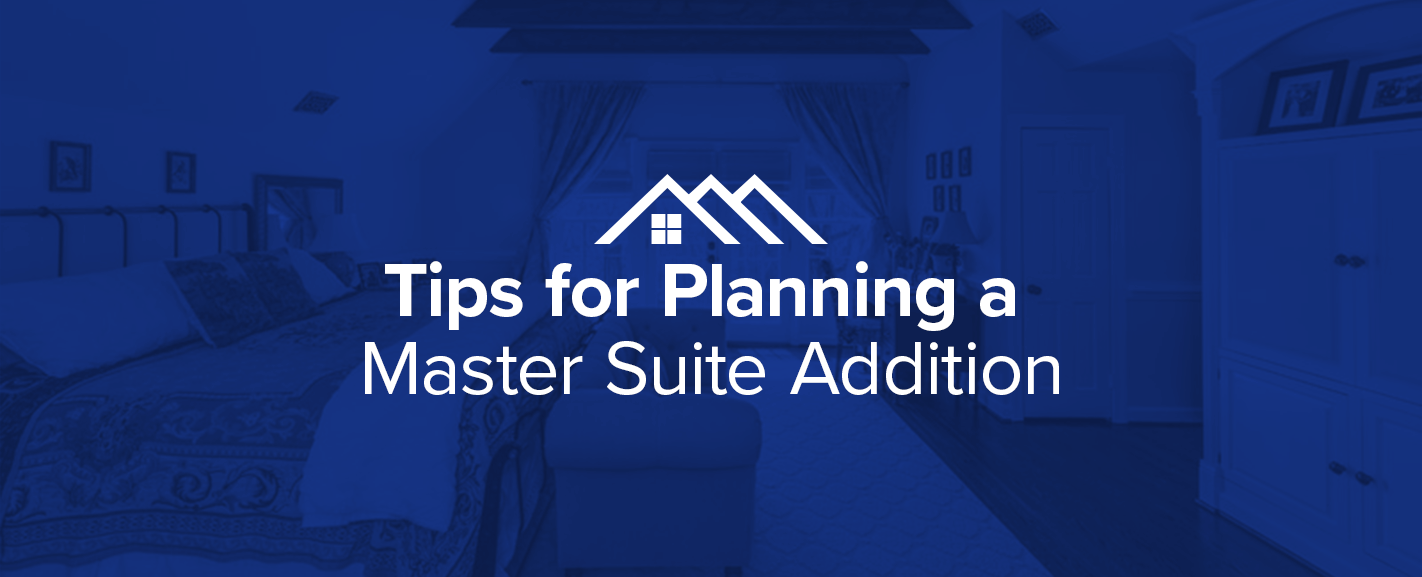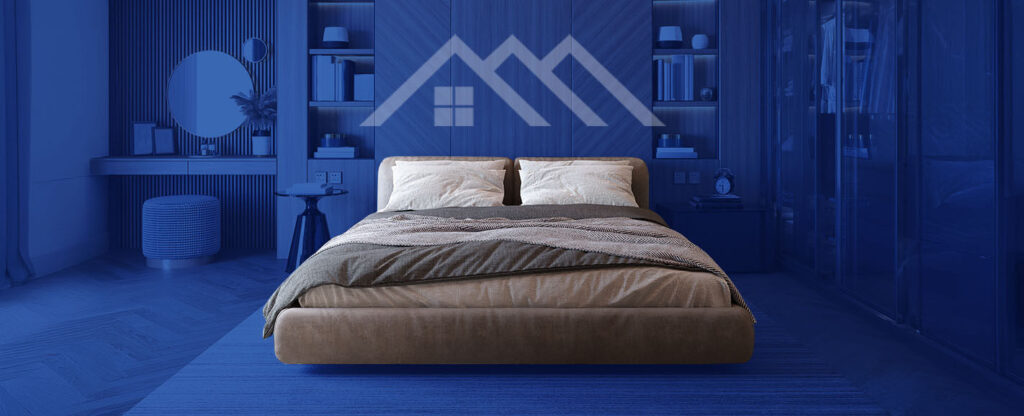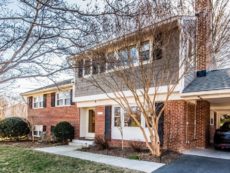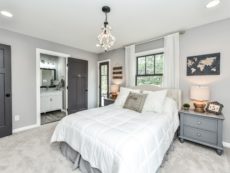Tips for Planning a Master Suite Addition

Tips for Planning a Master Suite Addition
Master suite additions are one of the most popular home additions today — and for a good reason. Today’s primary bedrooms are trending toward larger, more luxurious rooms. They often have their own bathroom included, as well as plenty of other unique features.
If you feel like your bedroom is too small, you want the modern convenience of extra storage or you’d like an en suite bathroom with spa-like amenities, a master suite addition may be the solution you need. When you’re planning an owner’s suite addition, there’s an endless variety of special features that can make your space more comfortable, spacious and personalized to your needs.
What Is a Master en Suite?
If you’ve researched a master suite addition, you’ve likely come across the term “master en suite.” This mashup of English and French phrasing has become the gold standard in master bedroom planning. The original meaning of “en suite” is following or afterward. However, when used in this way for homebuilding, it means connected or in the room.
The most basic definition of a master en suite generally means a bedroom with a bathroom inside or connected. But many primary en suite rooms go far beyond the basics and can include luxurious materials and special features.
Modern Benefits of Adding a Master Suite
There are many reasons that master suite additions are so popular right now. First, they can increase the value of the home, and you can see a significant return on investment (ROI) when it’s time to sell your home. Having an owner’s suite can also increase your enjoyment and satisfaction with your home, which can be even more valuable than ROI.
A primary suite simply makes the bedroom feel more luxurious, and it adds plenty of convenience and privacy. If there are children in your home or frequent guests, there’s no need to share bathrooms or worry about stumbling down a dark hallway in the middle of the night and waking other members of the household. Adding other features besides a bathroom means you can have whatever you want right in the comfort and privacy of your bedroom.
6 Tips for Planning Your Master Suite Addition
When you’re ready to start planning your master suite addition, there are many things to consider. These tips can help you organize your ideas and priorities and get the owner’s bedroom addition you’ve always wanted:
1. Decide on the Location for Your Addition
Before you start planning any details and building your addition, one of the first steps is to think about your options for where the new room can go. Perhaps you have a bedroom with room to expand, or maybe you’ll need to add a whole new area to the house. In the case of adding a master suite to a ranch house or single-story home, you’ll want to think about the ideal location for the addition. Determine where you may have space to expand, and whether you may lose out on front yard or backyard space.
You’ll also want to think about where the master suite will connect to the rest of the home. For example, you may not want your new first-floor master suite to connect directly to your kitchen area. Also consider issues like privacy or the view from your bedroom windows and think about which direction you’d like your new room to face. Your architect can take all these considerations into account, present your best options and help you make this important decision.
One of the most important aspects of an add-on master bedroom suite plan is deciding between a first-story addition and a second-story one:
- First-story additions: Adding a first-floor master suite to your home may take away more yard space and will require a slab or foundation of some kind. These types of additions may be the easiest to build and the least disruptive to your daily lives in the house during construction.
- Second-story additions: A second-floor master suite addition could potentially preserve more of your yard area, but it is a larger construction project. It can require strengthening the existing structures of the home, including the rooms underneath the new bedroom. The existing roof structure will be removed and reshaped, and other elements such as HVAC systems, electrical wiring and plumbing may affect the walls and ceilings of the rooms below.
2. Identify Your Priorities for the Master Suite
As you plan your master suite, you can truly design the room of your dreams with any special features you can imagine. Primary bedrooms are deeply personal spaces and can be customized to your liking. Consider these details as you organize your priorities for the room:
- Storage opportunities: Think about closet spaces — do you want a large walk-in closet? Or do you want separate closets for you and your partner? How about an extra closet in the bathroom area for towels and supplies? Think about any additional shelving or built-in cabinets you may want in the suite.
- Setting and placement of the room: Will you be able to utilize beautiful views for your new room? Will you have a patio or balcony attached? Your designer can use these aspects to ensure your room maximizes the best views and natural light exposure.
- Privacy: The level of privacy you desire can inform where you should locate your addition, as well as how to orient the layout of the room, and place windows and doors. Consider your proximity to neighbors’ homes and how busy your street is. Skylights can bring in natural light if you aren’t able to use large windows. Additionally, consider if you prefer a more open concept space or more private areas in the suite. Separate toilet and shower areas can add a sense of comfort and luxury, too.
- Noise issues: You may want to utilize noise-reducing features in your suite if you live in a busy area or if the room is constructed above other rooms in the home.
- Doorway styles and sizes: Think about the types of doors you’d like in your space. You may need additional doors if an outdoor patio or balcony will be a part of the design, as well as doorways to bathrooms and closets. Wider doorways are useful for moving in larger furniture, as well as accounting for accessibility concerns.
- Furniture: If you already have furniture you want in the space, think about its size and placement in the room. Make sure your design has room for your furniture, especially if you have special or larger pieces. Your designer can incorporate your furniture into the design so everything fits in the room the way you want it. Consider placement of electrical outlets too, especially if you have any unique lighting ideas or other elements like a television or stereo equipment you’d like in the room.
- Maintenance: As you choose the materials and special elements for your owner’s bedroom, consider the levels of maintenance and cleaning you’re comfortable with. For example, custom tile work or stone countertops may be more difficult to clean. Carpeting instead of hardwood floors in a bedroom may be harder to clean and not as durable. Consider whether your priority is to have a particular look or something that’s easy to clean and maintain.
3. Consider Any Special Needs
You want your new space to be welcoming and accommodating for you and your partner. Consider your height when planning things like countertops, shelving and special fixtures. If there are any special health concerns or mobility issues, factor these into the design of the room. A professional designer can work with any special requirements to make a room that works with your needs and abilities.
Some potential accessibility designs to consider include:
- Modern features: Modern technology and design elevate your primary suite’s luxury and accessibility. Consider options like automated window shades, a programmable thermostat and smart lighting.
- Extra space: Add extra room for moving around your space with a wheelchair or walker. Try to plan for wide doorways with a straight approach.
- Convenient closets: Consider having lower shelves and closet rods to make things easier to reach.
- Good lighting: Having good overhead lighting installed will make things in your master suite easier to see.
- Smooth flooring: Choose all hardwood or tile flooring for your suite. Avoid having a transition from carpet to tile between the bedroom and bathroom if you want wheelchair-friendly flooring that also reduces tripping hazards.
- Accessible window heights: If you or your partner uses a wheelchair, consider lower window placements or taller windows that take up more wall space to allow everyone to enjoy the views outside.
When planning your primary bedroom and bathroom home additions, think about the future, as well. If you’re remodeling your forever home, the above features will help you age into your master suite.
4. Don’t Forget About the Exterior of Your Addition
It’s easy to get caught up with how the interior of your new master bedroom addition will look and to overlook the exterior features of the project. You may have noticed a home before with an obvious addition that doesn’t blend as well with the rest of the house. Any type of new addition to a home should blend in seamlessly with the existing architecture and design of the home.
With this in mind, consider how the outside of your home will change with a new addition, even early on in your planning process. Think about the physical space the new addition will take up and where it will be located. You’ll also want to consider how the roofline may change and how that affects the overall look of the home.
The exterior details can make a bigger difference than you might think when it comes to blending the addition into the rest of the house. These details can include doors, windows, siding or facade options, exterior trim, roofing styles and materials, and any other exterior features you use. Match all these elements to the original structure and style of the home — or at least choose colors and styles that make sense and blend in with the whole home. When you work with an architect or professional design-build team, they can help you choose an appropriate design for your addition and present the best options.
5. Consider Interior Details and Luxurious Upgrades
Master bedroom suite plans can be very personal and give you the opportunity to customize the bedroom suite of your dreams. In the planning stages, think about what your top priorities are for luxury items and fixtures, as well as what your space and budget allow for. There are many options available for your new space, so it’s a good idea to figure out which items are must-haves and which would be nice to have if they fit in.
Consider these details for your new addition:
- Flooring: The options for flooring span a range of styles, materials and budgets. Hardwood flooring is popular for bedrooms. Custom tile work is a luxurious and beautiful upgrade for bathrooms. Heated flooring in the bathroom is another option that provides the ultimate in comfort, especially for a master suite addition in cooler places like Washington, D.C., Maryland and Northern Virginia.
- Storage upgrades: This can include walk-in closets, dual closets and built-in shelving or cabinet work. Stone countertops on cabinets give a luxurious touch.
- Bathroom fixtures: Consider bathroom upgrades like dual shower heads, a walk-in shower, rainfall shower, built-in shower features like benches or niches for storage, separate bath and shower, a free-standing bath, jets in the bathtub and more. Dual sinks or dual vanities are also nice upgrades.
- Smaller details: Some of the smallest upgrades can make a master suite feel more luxurious. These details could include the door handles, knobs and pulls on cabinet doors, plumbing fixtures, mirrors, lighting fixtures and more. Consider adding a towel warmer, steam feature or other spa-like upgrades. Even the shower drains can be made more beautiful and luxurious with a linear drain instead of the standard.
- Entertainment and convenience: Many homeowners enjoy features like a private bar area, fireplace, or built-in entertainment systems for watching TV or playing music in their master suite. You can customize your room to your preferences, creating the ultimate retreat for relaxation.
- Architectural features: Consider adding unique architectural embellishments to your room like a tray ceiling, including uplighting, crown molding or interesting trim. You may also want features like French doors, Palladian windows, skylights or other uniquely designed windows.
6. Work With an Experienced Design-Build Team
While it is good to have plans for an add-on master bedroom suite, one of the most important tips is to work with expert designers and builders from the start. A quality design-build team like Ideal Construction & Remodeling can help you every step of the way, from ideas and planning to construction.
For any addition project, there may be zoning laws, building codes or other special considerations like height allowances, historic preservation area rules and space allowances between buildings. Professional architects, designers and builders can navigate these issues with ease, ensuring your project meets all local standards while providing the master bedroom floor plans of your dreams. These professionals can also help you understand what works with your existing home and determine the appropriate amount of space to fit in all your desired features.
Why Choose Ideal Construction & Remodeling for a Primary Suite Addition?
A quality design-build team like Ideal Construction & Remodeling will help you every step of the way, from ideas and planning to construction. Choose our home remodelers and contractors near Northern Virginia, D.C. and Maryland for a comprehensive design-build process tailored to your needs. We’ll take the time to plan a master suite addition that blends harmoniously with your home’s interior and exterior, considering both structure and aesthetics.
We take pride in the work we do, transforming your home with modern, luxurious conveniences and design elements. View our testimonials to see what past clients loved about our additions in D.C., Northern Virginia and Maryland.
Design Your Dream Master Suite With Ideal Construction & Remodeling
If you’re in the Northern Virginia, Maryland or Washington, D.C. area, Ideal Construction & Remodeling is your go-to design-build firm for master suite additions. With our experienced team, you get the benefit of a single point of contact throughout your entire project and professional help from the idea stage to the construction stage. Ready to learn more about how we can help you get the modern master suite you’ve always dreamed of? Contact us today to schedule your free, in-home consultation.











